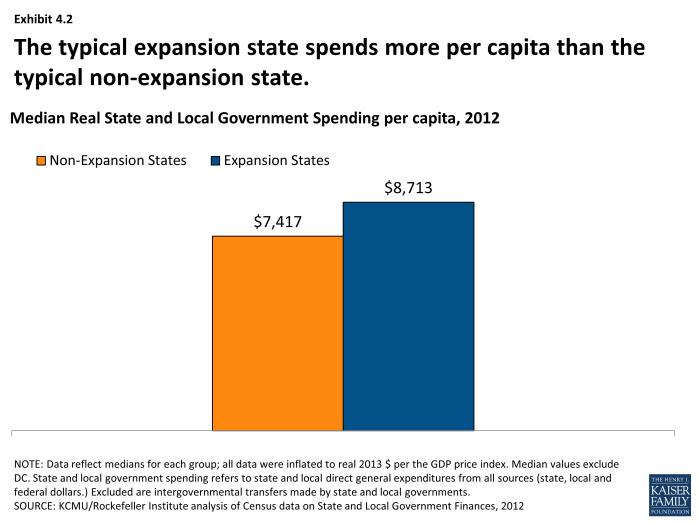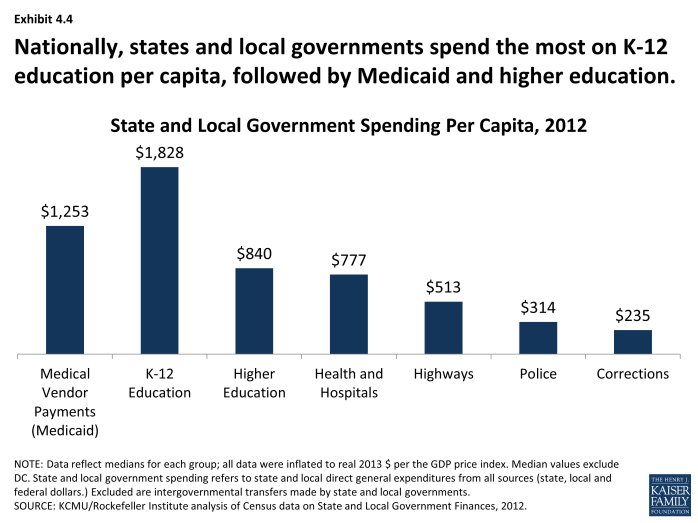Economic and Fiscal Trends in Expansion and Non-Expansion States: What We Know Leading Up to 2014
How Do Expansion And Non-Expansion States Compare? - State Budgets
A significant part of discussions in states over the adoption of the Medicaid expansion has been about state spending priorities. Unlike the federal government, states are generally required to balance their budgets; budgets therefore are a reflection of spending priorities within available resources. Several key factors include total state and local budget spending (spending from all sources – state, federal, and local) as well as spending across categories. Data in this section reflect total spending by state and local governments; this includes federal dollars spent by states and localities as well as spending from state and local sources. In state budgets, Medicaid financing is unique compared to other state spending programs due to the federal matching structure. For those states that adopt the expansion, the share of funding for Medicaid from federal dollars is expected to increase given the higher matching rate for those newly eligible under the Medicaid expansion.
Total State and Local Spending Per Capita
- Spending by state and local governments has slowed in recent years since the Great Recession; direct general expenditures actually declined in 2011 and 2012 compared to the prior year. (Exhibit 4.1)
- The typical expansion state has state and local government spending that is 17% more per-capita than the typical non-expansion state ($8,713 vs. $7,414). (Exhibit 4.2)
- Wyoming and Louisiana are notable exceptions; both are non-expansion states that spent more per-capita than many expansion states. Some expansion states (e.g. Arizona and Nevada) spent notably less than the typical non-expansion state. (Exhibit 4.3)
Distribution Across Spending Categories
- Nationally, state and local governments spent the largest amount (federal, state and local dollars) on a per capita basis for K-12 education, followed by Medicaid-related spending and higher education in FY 2012. (Exhibit 4.4)
- The typical expansion state spent more per capita on Medicaid-related spending (+24%); K-12 education (+18%); police (+20%) and corrections (+11%). (Exhibit 4.5)
- By contrast, the typical non-expansion state spent more per-capita on health and hospitals (+21%), highways (+5%) and higher education (+3%) than the typical expansion state. (Exhibit 4.5) This may be a reflection of the more rural nature of non-expansion states (hence, higher spending on highways) as well as that non-expansion states have more hospitals owned by state and local governments (leading to higher spending on health and hospitals.) 1
Change in spending on Medicaid, K-12, Health and Hospitals over time
- Medicaid-related spending continued to grow during the Great Recession while spending on health and hospitals slowed and spending through K-12 education declined. (Exhibit 4.6)
- Following the start of the Great Recession, the typical expansion state saw stronger growth in real per capita state-local government spending on Medicaid in comparison to non-expansion states. (Exhibit 4.7) However, real Medicaid spending per capita declined from 2011-2012, which would have included the end of additional federal matching funds temporarily extended during the Great Recession.2
- Following the start of the Great Recession, both groups saw declines in K-12 spending, though the declines in K-12 spending were much smaller in the typical expansion state. (-0.8% vs. -1.9% on an average annual basis from 2008 to 2012.) (Exhibit 4.7)









